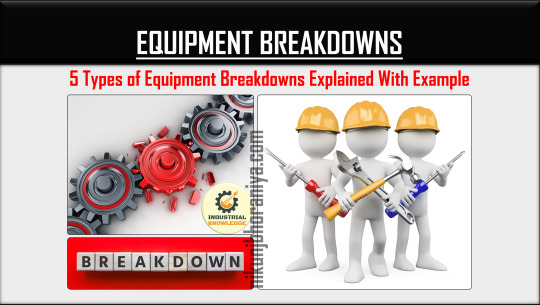#IATF
Text

➡️ What is an Equipment Breakdown? Types of Breakdowns | Examples
#lean six sigma#excellence#tutorial#kaizen#iso9001#leansixsigma#tutorials#leanmanufacturing#5s#oee#industrialengineering#pokayoke#7qctools#histogram#tpm#iatf16949#g8d#iatf#qms#vsmstudy#flowchart#histograms#smartgoal#DMAIC#5Why#BlackBelt#GreenBelt#YellowBelt
2 notes
·
View notes
Text

Save the date, y'all
5 notes
·
View notes
Link
Chapter 4 is UP!!!
4 notes
·
View notes
Text
Every customer seems to have the same consistent expectations: faster, less wasteful delivery of higher-quality components. How, therefore, can an auto supplier fulfil these constantly evolving obligations? With a focus on methodical procedures, enhanced customer satisfaction, and ongoing improvement, the IATF 16949 certification provides a clear foundation for creating a quality management system (QMS) that satisfies client expectations. IATF 16949 certification gives numerous advantages for the Automotive industry. In this article, we mention some advantages of IATF 16949.
#iatf#iatf documents#iatf 16949 documents#iatf 16949 documents kit#editable iatf 16949 documents#iatf 16949 documents packages
0 notes
Text
IATF 16949 vs. ISO 9001: Understanding the Key Differences
IATF 16949 vs. ISO 9001: Understanding the Key Differences
Both IATF 16949 and ISO 9001 are internationally recognized quality management standards, but they cater to different industries and have unique requirements. Here's a breakdown of the key differences between IATF 16949 and ISO 9001:
1. Industry Focus:
ISO 9001: It is a generic quality management standard applicable to various industries and organizations of any size.
IATF 16949: Specifically designed for the automotive industry, addressing the unique challenges and requirements of automotive manufacturers and suppliers.
2. Applicability:
ISO 9001: Suitable for all types of organizations, regardless of their involvement in the automotive sector.
IATF 16949: Primarily intended for organizations in the automotive supply chain, including manufacturers, suppliers, and service providers.
3. Customer-Specific Requirements:
ISO 9001: Focuses on meeting customer requirements but doesn't specify industry-specific customer requirements.
IATF 16949: Includes additional requirements that are specific to the automotive industry, reflecting the expectations of automotive OEMs (Original Equipment Manufacturers).
4. Product Safety:
ISO 9001: While it emphasizes the need to meet customer requirements, it doesn't explicitly address product safety.
IATF 16949: Places specific emphasis on product safety, reflecting the critical nature of safety considerations in the automotive industry.
5. Risk-Based Thinking:
ISO 9001: Encourages a general approach to risk-based thinking.
IATF 16949: Requires a more detailed and specific focus on risk management, including the identification and mitigation of risks related to the automotive supply chain.
6. Process Approach:
ISO 9001: Emphasizes a process approach to quality management.
IATF 16949: Extends the process approach to include a more detailed focus on specific automotive processes and requirements.
7. Product Development:
ISO 9001: Addresses product realization processes in a general sense.
IATF 16949: Includes more detailed requirements for product development and validation processes, reflecting the complexity of the automotive product development lifecycle.
8. External Certification Bodies:
ISO 9001: Can be certified by various accredited certification bodies.
IATF 16949: Requires certification through specifically accredited bodies recognized by the International Automotive Task Force (IATF).
9. Change Management:
ISO 9001: Requires organizations to manage changes to the quality management system.
IATF 16949: Places a stronger emphasis on change management, especially in the context of automotive processes and products.
Understanding these key differences is crucial for organizations in the automotive industry as they navigate the complexities of quality management. While both standards share common elements, the industry-specific focus of IATF 16949 sets it apart and addresses the distinct challenges faced by automotive manufacturers and suppliers.
0 notes
Text
WHAT ARE THE AUTOMOTIVE CORE TOOLS?

To achieve IATF 16949 certification, companies must implement the five core tools, which are:
Advanced Product Quality Planning (APQP): This tool ensures that products are designed with quality in mind from the beginning and that the manufacturing process is well-prepared to deliver consistent quality.
Failure Mode and Effects Analysis (FMEA): FMEA helps in identifying potential failure modes in processes, products, or systems, allowing proactive risk mitigation.
Measurement System Analysis (MSA): MSA ensures that measurement systems used in quality control are accurate, reliable, and consistent.
Statistical Process Control (SPC): SPC involves monitoring and controlling production processes through statistical methods to maintain consistency and reduce defects.
Production Part Approval Process (PPAP): PPAP validates that production processes meet customer requirements, ensuring that manufactured parts meet the specified standards.
#IATF#iatf 16949#iatf 16949 2016#iatf 16949 consultant#iatf 16949 certification#iatf 16949 training#iatf 16949 implementation#iatf16949#automotive
0 notes
Text
instagram
#DOH and #IATF has recommended to Pres. Marcos, Jr. that there's no need to bring back mandatory #facemask policy except for at-risk individuals and high-risk situations.
#COVID19Update #Philippines #PH #COVID19
1 note
·
View note
Text
Navigating IATF 16949 Process: A Guide for Automotive Manufacturers

For auto manufacturers around the world, being IATF 16949-certified is significant. It's the business' essential benchmark for quality management. IATF 16949 supplements the more conventional ISO 9001 certification family, adding much significant auto industry-explicit measurements.
By January 2024, there were at that point around 90K IATF 16949-certified production sites internationally, and this still goes on. Consequently, this certification conspire is profoundly pursued by automakers across the globe.
Notwithstanding, IATF 16949 sets an exclusive expectation for makers. The certificate cycle is thorough. It surveys multiple parts of a plant, which incorporates both technical and regulatory components.
The IATF 16949 Process regularly requires a couple of days to half a month (depending on the plant's size). However, the planning system can without much of a stretch require as long as a year, contingent upon the plant's ongoing status.
Step-by-step Guide to Obtaining IATF 16949
To be IATF 16949 certified, your plant should be evaluated by a regulatory IATF auditor organization. Since the actual accreditation is exceptionally broad, you'll have to set up your plant far ahead of time. Without appropriate planning, almost certainly, your plant will not satisfy the IATF 16949 Requirements.
Whether you're setting it up freely or by employing outer experts, here are the general moves toward planning for an IATF 16949 certification:
Step 1: Establish a Certification Team
The initial step is to make an internal IATF 16949 certificate team inside your plant. The group in a perfect world comprises a delegate from every workstation. This is to guarantee that there's a reasonable line of communication across all workstations in your plant.
Step 2: Setting of Targets and Resources
After the group has been framed, now is the right time to sit together and decide on the following angles:
The roles and responsibilities of your colleagues.
The resources are dispensed for the planning and certificate process.
The planning and certification checklist. What amount of time should the planning require? When do you intend to take the IATF 16949 audit from an authority IATF auditor? Should the group meet every day or week after week? What's more, other time-related perspectives.
Whether to set up the certification freely or by recruiting external advisors.
Step 3: Provide Training for Your Team
The subsequent stage is to illuminate your team regarding the IATF 16949's planning and certificate process.
Step 4: Make an Audit Checklist
After your team has completely recognized the evaluated parts of the IATF 16949 certification, now is the right time to conduct an internal audit. This internal audit will survey your plant's current exhibition and how it analyzes the IATF 16949 requirement.
Plan this by drafting an audit agenda. There, you ought to list the Key Performance Indicators (KPIs) and credits reviewed in the IATF 16949 certificate. The 10-part rule contains many surveyed KPIs and ascribes, so take as much time as needed to remember everything for your audit checklist.
Use complying advanced agendas as your IATF 16949 audit checklist stage. You can likewise incorporate recordings and pictures there as additional references.
Step 5: Organize an Internal Audit
When the audit checklist agenda is finished, now is the ideal time to involve it in an inner review. As recently referenced, this internal audit means to decide your plant's ongoing compliance rate with the IATF 16949 guidelines. Albeit this is only a counterfeit audit, it ought to mirror the genuine IATF 16949 audit agenda.
In this stage, ensure that all KPIs and ascribes in the IATF 16949 rule are considered. Toward the completion of each audit, you can consequently create an audit document and utilize this info for compliance purposes and as a benchmark to follow your future advancement.
Step 6: Examine Your Internal Audit Outcomes
After you've gotten your internal audit results, the subsequent stage is to examine them. See which KPIs and credits are IATF 16949-agreeable, and which ones are not.
For the agreeable KPIs and ascribes incredible work, and maintain it! For the KPIs and credits that haven't satisfied the IATF 16949 Requirements, you'll have to carry out certain upgrades, which we will additionally talk about in the following stage.
At this stage, it's generally expected that a huge lump of your requirements are as yet unacceptable. That is the principal thought of running an internal audit: To view your plant's flimsy parts and fix them before the genuine certification audit.
Step 7: Make Necessary Improvements & Re-take Internal Audit
The past step pinpointed the inadmissible KPIs and credits. Presently, you ought to execute the enhancements expected to make these KPIs and credits, IATF 16949 agreeable. Obviously, the kind of progress will rely upon the KPI and property concerned.
After you've finished all upgrades for the inadmissible KPIs and ascribes, it's prescribed to take further audit until all KPIs and credits are demonstrated agreeable. A few organizations like to lead this second internal audit review just on inadmissible KPIs and credits.
Step 8: Make Agendas with the Accreditation Body.
In the wake of finishing all the planning steps, now is the right time to continue to the last stage: taking an IATF 16949 certification review. You ought to reach one of the authority IATF examiner’s associations and solicit a certification review.
They're available on all sides of the globe. Thus, finding one situated in your nation or district ought not to be troublesome.
How long is the audit cycle valid? Indeed, the IATF has a standardized audit course of events. The span depends on the number of employees at the reviewed plant. The more employees a plant has, the more drawn out the audit process will take.
Maintaining the IATF 16949 Standard
To keep up with IATF Certification, organizations should keep on gathering the requirements of the IATF 16949 standard. Also, they should keep a cutting-edge and powerful quality management system that addresses the issues of their customers and other partners.
To keep up with your certification by intermittently going through Gap Analysis and rolling out any essential improvements to your process. This will guarantee that you can keep on involving the IATF 16949 regulations in your association.
Conclusion
All in all, handling the IATF 16949 Process is a thorough yet compensating venture for automakers. This guide frames the fundamental advances associated with exploring the certification cycle, accentuating the significance of intensive planning, internal audit, and persistent improvement.
By laying out an internal accreditation team, setting clear targets, and giving training, associations can successfully smooth out their way to certification. The audit process fills in as a critical designated spot for distinguishing areas of progress and ensuring compliance with IATF 16949 guidelines.
0 notes
Text

➡️ What is a Key Performance Indicator (KPI)? Guide and Examples
#lean six sigma#excellence#tutorial#kaizen#iso9001#leansixsigma#tutorials#leanmanufacturing#5s#oee#industrialengineering#pokayoke#7qctools#histogram#tpm#iatf16949#g8d#iatf#qms#vsmstudy#flowchart#histograms#smartgoal#DMAIC#5Why#BlackBelt#GreenBelt#YellowBelt
2 notes
·
View notes
Text
Navigating the Road to IATF 16949 Certification: Driving Quality Excellence in Automotive Industry
Introduction to IATF 16949 Certification
In the highly competitive automotive industry, quality management systems play a critical role in ensuring the delivery of safe and reliable vehicles to consumers worldwide. The International Automotive Task Force (IATF) 16949 certification sets the standard for quality management systems in the automotive sector. This certification is recognized globally and is essential for automotive manufacturers and their supply chain partners.
Understanding the Importance of IATF 16949 Certification
Enhancing Product Quality and Safety: IATF 16949 certification emphasizes a proactive approach to quality management, focusing on preventing defects and errors rather than simply detecting them after production. By adhering to the rigorous requirements of this standard, automotive companies can enhance the quality and safety of their products.
Meeting Customer Requirements:Automotive manufacturers must comply with the specific quality standards and requirements of their customers, which often include OEMs (Original Equipment Manufacturers). Achieving IATF 16949 certification demonstrates a company's commitment to meeting or exceeding these customer expectations, fostering trust and long-term relationships.
Driving Continuous Improvement:Continuous improvement is a core principle of IATF 16949 certification. By implementing processes for identifying areas of inefficiency or non-conformity, automotive companies can systematically address these issues and drive ongoing improvements in quality, efficiency, and customer satisfaction.
Key Elements of IATF 16949 Certification
Process Approach: IATF 16949 certification requires organizations to adopt a process approach to quality management. This involves identifying and managing interconnected processes within the organization to achieve desired outcomes efficiently.
Risk-Based Thinking:A key feature of IATF 16949 is the emphasis on risk-based thinking. Automotive companies are required to assess and address risks and opportunities throughout their operations, particularly concerning product quality, safety, and regulatory compliance.
Customer-Specific Requirements:IATF 16949 certification incorporates customer-specific requirements, ensuring that automotive suppliers meet the unique quality standards and expectations of their clients. This includes requirements related to product design, manufacturing processes, and service delivery.
Benefits of IATF 16949 Certification
Enhanced Credibility and Reputation:IATF 16949 certification enhances an organization's credibility within the automotive industry and among its customers. It serves as a tangible demonstration of the company's commitment to quality and continuous improvement.
Access to New Markets: IATF 16949 certification is recognized and accepted by automotive manufacturers worldwide. For suppliers seeking to expand their business globally, this certification opens doors to new markets and opportunities for collaboration.
Operational Efficiency and Cost Savings: By implementing robust quality management systems, organizations can streamline their operations, reduce waste, and minimize the risk of defects and recalls. This results in improved operational efficiency and significant cost savings over time.
Conclusion
IATF 16949 certification is a testament to an organization's dedication to quality, customer satisfaction, and continuous improvement in the automotive industry. By adhering to the stringent requirements of this standard, companies can strengthen their competitive position, drive innovation, and ensure the delivery of safe and reliable vehicles to consumers worldwide.
0 notes
Text

Graphic design is my fucking burden
#art#other content#iatf#merry Christmas#she is not wearing eyeliner or lipstick. my pencil just got blunt
3 notes
·
View notes
Text
throwback to the first time i watched the proshot and i was like. hold on. why does it look like that (creepy)(green). i know i've attempted to rationalize the choice in the past but hm. actually. no.
#the grinning man#burning thoughts#tip: this is unnecessary#they did dial it back a bit in london i think but. you know. a little hard to see color in a bootleg#shoutout to rob casey (lighting designer) for being brave and losing the footlights#are we ready to talk about the lighting differences between iatfs from bristol to london because i have a draft about it. believe it or not
0 notes